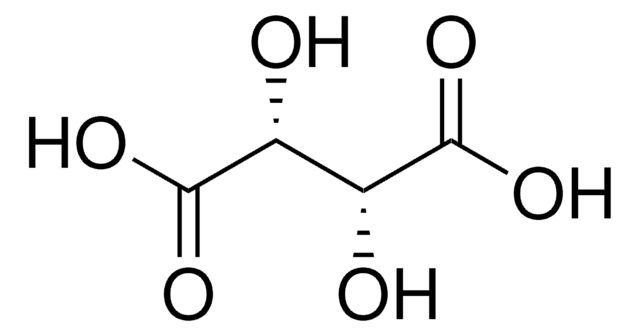推薦產品
蒸汽密度
5.18 (vs air)
品質等級
產品線
BioXtra
化驗
≥98%
形狀
powder
自燃溫度
797 °F
雜質
≤0.002% Phosphorus (P)
≤0.1% Insoluble matter
燃燒殘留物
≤0.1%
mp
170-172 °C (lit.)
溶解度
H2O: 1 M at 20 °C, clear, colorless
負離子痕跡
chloride (Cl-): ≤0.05%
sulfate (SO42-): ≤0.05%
正離子痕跡
Al: ≤0.002%
Ca: ≤0.005%
Cu: ≤0.0005%
Fe: ≤0.005%
K: ≤0.005%
Mg: ≤0.001%
NH4+: ≤0.05%
Na: ≤0.005%
Pb: ≤0.001%
Zn: ≤0.0005%
SMILES 字串
O[C@H]([C@@H](O)C(O)=O)C(O)=O
InChI
1S/C4H6O6/c5-1(3(7)8)2(6)4(9)10/h1-2,5-6H,(H,7,8)(H,9,10)/t1-,2-/m1/s1
InChI 密鑰
FEWJPZIEWOKRBE-JCYAYHJZSA-N
尋找類似的產品? 前往 產品比較指南
相關類別
一般說明
Tartaric acid is a dicarboxylic acid and occurs as two enantiomers and an achiral meso compound. The L-(+)-tartaric acid is extensively found in nature. It is an acid present in fruits such as grapes and bananas. It possesses an astringent and citrus flavor.
應用
L-(+)-Tartaric acid has been used:
- in filter-sterilized synthetic grape juice for feast fermentation
- in crystallization experiment
- to test the influence of stereospecific interactions between stereoisomers of tartaric acid and proteins during crystallogenesis
生化/生理作用
L-(+)-Tartaric acid serves as a donor ligand for biological processes. It is used as a food additive in candies and soft drinks to impart a sour taste.
訊號詞
Danger
危險聲明
危險分類
Eye Dam. 1
儲存類別代碼
11 - Combustible Solids
水污染物質分類(WGK)
WGK 1
閃點(°F)
302.0 °F - closed cup
閃點(°C)
150 °C - closed cup
個人防護裝備
dust mask type N95 (US), Eyeshields, Gloves
客戶也查看了
Acetogenin (Polypriopionate) Derived Auxiliaries: Tartaric Acid
Comprehensive Chirality (2012)
4.16-human-environment interactions?Taste
Izawa K, et al.
Comprehensive Natural Products II, 631-671 (2010)
Higher Denticity Ligands
Comprehensive Coordination Chemistry II (2003)
Effects of protein purity and precipitant stereochemistry on the crystallization of thaumatin
Asherie N, et al.
Crystal Growth & Design, 8(12), 4200-4207 (2008)
Nina Piggott et al.
G3 (Bethesda, Md.), 1(5), 353-367 (2012-03-03)
The ability of cells to respond to environmental changes and adapt their metabolism enables cell survival under stressful conditions. The budding yeast Saccharomyces cerevisiae (S. cerevisiae) is particularly well adapted to the harsh conditions of anaerobic wine fermentation. However, S.
我們的科學家團隊在所有研究領域都有豐富的經驗,包括生命科學、材料科學、化學合成、色譜、分析等.
聯絡技術服務





